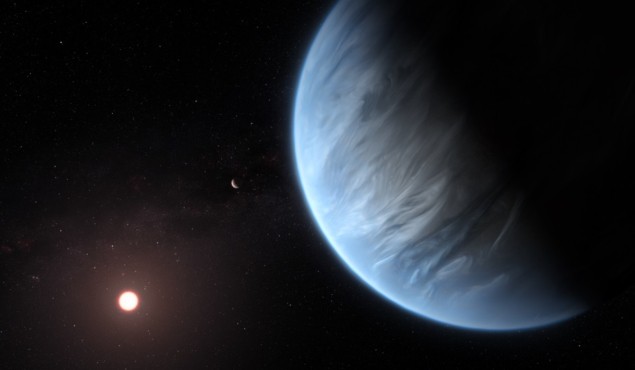
Water vapour has been detected in the atmosphere of a rocky planet 110 light-years from Earth. Called K2-18b, the planet orbits within the habitable zone of a red-dwarf star, which means that the planet could harbour life. The observations were made by astronomers at University College London, who used the Hubble Space Telescope. While the evidence for water vapour is compelling, the scientists say that the next generation of telescopes will be needed to gain a better understanding of the planet’s atmosphere.
Astronomers know of thousands of extrasolar planets – planets that orbit stars other than the Sun. As observation methods improve, scientists are beginning to study the atmospheres of some of these planets. Evidence for water in the atmospheres of distant gas giants – planets that resemble Saturn or Jupiter – has already been found, but this is the first time that water has been spotted in the atmosphere of distant Earth-like planet in the habitable zone of its star. This zone is a band of orbits in which liquid water – and possibly life – could exist on a planet.
K2-18b is not, however, identical to Earth. It is a “super Earth” that is eight times the mass of our world and completes one orbit of its star in just 33 Earth days.
Spectroscopic signature
Hubble’s Wide Field Camera 3 was used to observe eight transits of K2-18b. A transit occurs when a planet passes between the Earth and the planet’s companion star and results in a small drop in the amount of starlight that reaches an observing telescope. Some of the light that does reach the telescope during a transit has passed through the planet’s atmosphere and this light can be analysed for the spectroscopic signature of water.
The team analysed the spectroscopic data using three atmospheric models of K2-18b. The first model described the atmosphere as cloud-free and comprising only water, molecular hydrogen and helium. The second model was like the first but with the addition of molecular nitrogen. The third model included clouds, water, molecular hydrogen and helium.
Their analysis reveals a slight preference for the first model, but the likelihood of all three models have about the same statistical significance.
Is the Earth unique?
Angelos Tsiaras, who led the research, says “Finding water in a potentially habitable world other than Earth is incredibly exciting. K2-18b is not ‘Earth 2.0’ as it is significantly heavier and has a different atmospheric composition. However, it brings us closer to answering the fundamental question: Is the Earth unique?”
Team member Ingo Waldmann adds “With so many new super-Earths expected to be found over the next couple of decades, it is likely that this is the first discovery of many potentially habitable planets”.

Toxic gases in habitable zone could hinder emergence of alien life
Astronomers seeking further insight into the atmosphere of K2-18b may have to wait until the next generation of telescopes come online. Team member Giovanna Tinetti says, “Our discovery makes K2-18 b one of the most interesting targets for future study”. She adds, “Over 4000 exoplanets have been detected but we don’t know much about their composition and nature. By observing a large sample of planets, we hope to reveal secrets about their chemistry, formation and evolution.”
The observations are described in Nature Astronomy.
An independent measurement of water vapour on K2-18b has also been made by Björn Benneke of the University of Montreal and colleagues. This team also used the Wide Field Camera 3 and they describe their observations in a preprint on arXiv.



